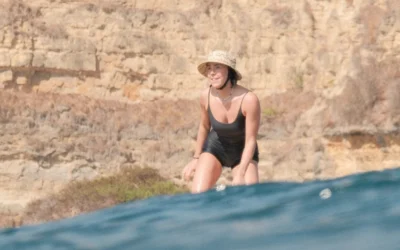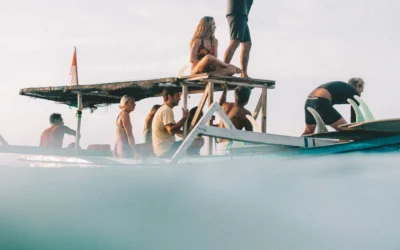Surfers are responsible for coming up with some of the most outlandish words and sayings of any sport.
Stoked. Gnarly. Pig dog. Cross-step. Froth.
If you have no idea what these words mean when they come out of a surfer’s mouth, you might call an ambulance thinking they’ve gone insane.
Truth is though that these are milder examples of surf slang and lingo.
You might even say they’re just the tip of a (very interesting and sometimes hard-to-decipher) iceberg.
There are lots more surfer slang where those words came from, but we want you to enjoy your trip without feeling like you need to learn a whole new language.
So, here’s our attempt at helping you understand ‘Surfanese’.
In this article you’ll learn:
- Whether it’s necessary to know surf lingo as a beginner surfer or inexperienced surfer
- How and where surf slang first developed
- How terms differ between longboarders and shortboarders
- Popular surf terminology and sayings
Let’s get cracking!
Do I need to understand ‘Surfanese’ to learn surfing?
First things first.
You might feel slightly apprehensive about the fact that surfing has its own rich language. Is it necessary to learn the different words and phrases before learning to surf though?
Absolutely not: an inexperienced surfer can still catch waves without being fluent in Surfanese.
Our surf coaches will brief you before paddling out and give you a crash course on surf slang.
Then, once in the water, they’ll provide easy-to-understand instructions to ensure you know exactly what to do in order to catch some epic rides!
This means you can book a longboard week or a stay at our village or retreat today – no PhD in surfer slang needed!
How did surf slang and surfer lingo develop?
Just like any subculture, surfers developed their own unique language as a way of encapsulating their shared experiences and the specific environment in which they surf.
Surfing lingo has its roots in the 1950s and 60s, when surfing culture exploded in popularity amongst the broader public in California and Hawaii.
As the lifestyle expanded, so did the unique vocabulary used by surfers to describe their experiences on the waves.
Words like ‘gnarly’ and ‘stoked’, which are now part of the mainstream vernacular, originated from this era. They were then echoed in pop culture and media, which only solidified their legitimacy amongst surfers.
But surfing terms aren’t just about novelty or maintaining a distinctive identity.
They also serve a practical purpose, allowing surfers to communicate quickly and efficiently about wave conditions, technique and surf safety.
In essence, these surfer slang terms represent a rich cultural tapestry woven together by a tight-knit global community bonded by their love for the ocean and the thrill of riding waves.
How does longboard lingo and shortboard lingo differ?
While both longboarders and shortboarders use common surf lingo, there are distinct differences in terminology that reflect the divergent styles and techniques of these two forms of surfing.
Longboarders = chilled and relaxed
Longboard surfers, known for their relaxed and laid-back style, infuse their language with terms that embody this chill approach.
Take the term ‘cruise’, for instance, which in longboarding lingo refers to effortlessly gliding along the wave, a reflection of the tranquil nature of their surfing style.
Similarly, phrases like ‘hang five’ or ‘hang ten’ – both referring to the act of positioning either five or all ten toes over the nose of the board – imply a certain nonchalant skill.
In contrast to the aggressive, fast-paced vernacular often associated with shortboard surfing, longboard language subtly echoes the grace, flow and inherent calm of the longboarding experience.
Shortboarders = dynamic and agressive
Shortboarders, with their dynamic and high-energy style, have crafted a lingo that mirrors this intensity.
Their terminology is often more radical and full of vigour, reflecting the adrenaline-fueled and daring nature of shortboarding. Terms like ‘shred’, ‘rip’ and ‘slash’ are common, depicting the aggressive techniques used to manoeuvre the board on the wave.
This intense vocabulary truly encapsulates the thrilling, high-octane world of shortboard surfing.
Indeed, many surf linguistics coexist in both longboarding and shortboarding worlds, creating an overlap that might confuse the untrained ear. Terms like ‘stoked’, ‘wipeout’ and ‘pointbreak’, are universal in the surfing community regardless of board preference.
Thus, understanding surf lingo transcends mere word knowledge; it’s about tuning in to the nuances of surfing culture.
Glossary of surfing terms and longboard terminology
Surfboard nose riding: This term refers to when a surfer rides on the front (the ‘nose’) of their board
Trim/Cruise: This is the act of adjusting one’s position on the board to maintain optimal speed and control
Hang ten: This iconic move involves the surfer positioning all ten toes off the edge of their board
Stoked: To be super excited
Oncoming wave: Refers to the waves breaking in front of you
Wipeout: Surf lingo for falling off your board while on a wave
Surf etiquette: A set of rules used by surfers to ensure everyone can enjoy a surf and fair surfing experience in crowded lineups
Glide: This is the term used to describe the smooth, effortless manner in which longboarders ride a wave
Barney or kook: Surfing slang for any surfer who acts foolishly on the waves. An aggressive surfer
Shore break: Breaking waves that land on the shoreline
Hang five: Similar to a hang ten but only five toes (from one foot) are hanging off the edge when a surfer rides a wave
Offshore winds: Winds that blow from the direction of the land out to sea, creating a smooth wave
Party wave: A wave ridden by more than one person in which all surfers agree to share
Onshore wind: Winds that blow from the direction of the sea towards land, creating rough and choppy waves
Wave pocket: The closest part of the wave to the curl. Where the wave’s power is strongest
Beach break/beachie: Where waves break over sand
Big wave surfers: Certified lunatics who ride huge waves (Nazare, Jaws, Mavericks) using a jet ski to tow them into the ride
Surfboard nose: The nose or uppermost section of your longboard
Tail: The rear of a surfboard. Opposite end to the nose beneath which the fins are located
Point Break: A point break is where waves break over rock or cobblestones (gradually undulating land)
Beginner surfers: Surfers who have either never surfed before or are only just learning to stand up
Froth/frothing: To be over-excited about conditions, a particular manoeuvre or just about anything really
Blow-in: A non-local surfer (take this one with a grain of salt… we’re practically all non-locals)
Big wave: A large breaking wave with a surfable wave face that’s only ridden by professionals
Green room: Surfing slang for the inside of a tube. The part of the wave that barrels
Bomb: An exceptionally large wave face
Turtle roll: The act of grabbing your rails while lying on your board and flipping yourself and the board upside down by rolling to one side as a breaking wave approaches so it washes over you
Choppy: Rough, turbulent water with poor surf conditions (caused by onshore winds)
Clean/Groomed: Smooth water with good surf conditions (caused by offshore winds)
Pushing the tail: A technique where the surfer rides a wave and pushes on the back of the board to lift the nose
Walking the board: The act of moving up and down the board. Most surfers do this in order to nose ride
Goofy foot: This term is used for surfers who ride with their right foot forward (opposite to regular – left foot forward)
Small waves: Waves under waist-high
Wave curl: Another name for the pocket
Set: Two waves or more that break one after another. When waves combine and break in a group
Green wave: An unbroken wave that can be caught and ridden
Broken wave: Broken waves that have turned into whitewash
Regular foot: Opposite of a goofy foot surfer (right foot forward), this term is used for surfers who ride with their left foot forward
Logger: This is a term for a surfer who prefers traditional longboarding styles
Gnarly: Referring to something heavy or dangerous that has happened
Soul arch: This refers to an elegant and stylish stance where the surfer arches their back and extends their arms
Cooking: Good surf conditions
Surfable waves: Any wave that looks like it could be surfed safely (discover the best time of year for surfable waves in Lombok here)
Cross-step: To step up the length of your board, crossing one foot over the other. A difficult longboarding manoeuvre to accomplish with grace
Cowabunga: An outdated (but fun to say) exclamation used to express excitement. More than just Bart Simpson’s cheeky catchphrase
Crest: The top of a wave
Takeoff: The act of taking off on a wave (from prone to standing up)
Cutback: A manoeuvre that redirects the surfboard back to the breaking part of the wave
Dawn Patrol: Surfing at dawn
Deck: The top surface of the surfboard
Ding: Damage to the surfboard
Cutback: When a surfer turns their board back towards the whitewash on an open face
Lineup: The takeoff zone at a surf break
Drop-in: Taking off on a wave that someone else is already riding
Next wave: The wave after the oncoming wave
Reef break: A wave that breaks over coral
Epic: Exceptionally good surf
Wave face: The unbroken part of the wave
Flat: No waves
Glassy: Ideal surf conditions where the water is calm and almost glass-like in appearance. Occurs when there’s little to no wind
Pearl/nose dive: This occurs when the nose of the board goes underwater, often causing the surfer to fall off
Stall: This is a technique used to slow the board down by leaning back and dragging a hand or foot in the water
Switch stance: This term is used when a surfer changes their standing position from regular to goofy, or vice versa
Cheater five: This refers to the act of hanging five while having the back foot further up the board than usual
Side slip: This happens when a surfer slides sideways down the face of the wave
Coffin: This is a fun and relaxed position where the surfer lays flat on their back on the board
Caught inside: When you become stuck in the zone where all the waves are breaking. Can be at any type of surf break (beach break, point break, reef break)
Rail to rail: This is a turning technique where the surfer shifts their weight from one rail (side) of the board to the other
Malibu/Log: A longboard with a straight outline, rounded nose with a round/square tail and a single fin configuration. 9 feet and longer
Mini mal: A shorter, more manoeuvrable longboard. Can be between 6 and 8 feet with anywhere from one to three fins
Conclusion
So that’s it! As you can see, there’s a lot to take in when it comes to our glossary of surfing terms.
Everything from a party wave to dawn patrol and turtle roll is all surfing lingo that you might hear during a stay at Xanadu.
So don’t worry about memorising all of these surfing terms before you come – we’ll make sure you end your surf trip knowing exactly how to hang ten on a peeling wave thanks to our unique brand of surfer lingo – enjoy!




